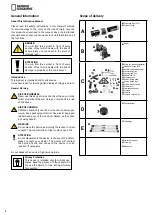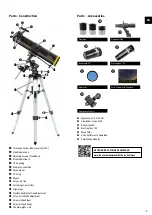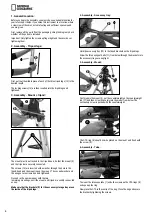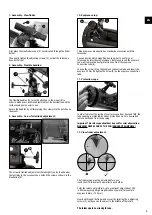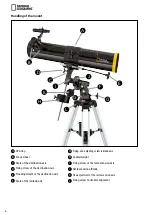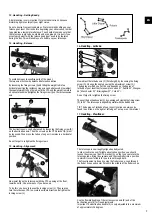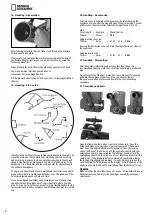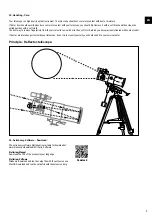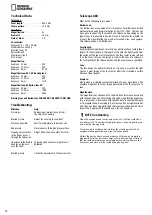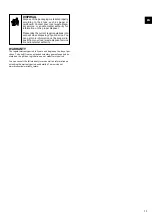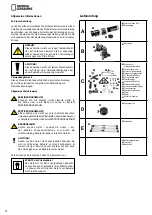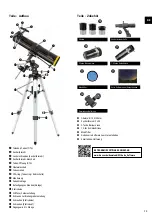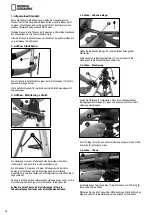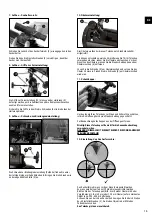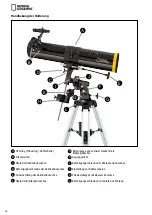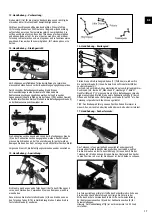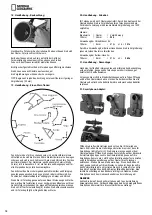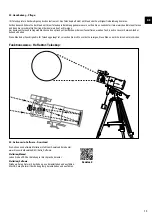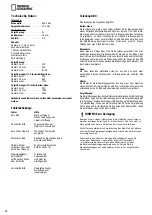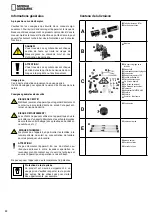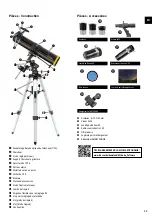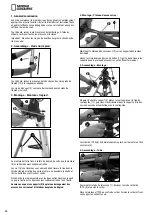
10
Technical Data
Telescope:
Focal length:
. . . . . . . . . . . . . . .
694.2 mm
Clear aperture:
. . . . . . . . . . . . .
75.2 mm
Viewfinder:
Magnification:
. . . . . . . . . . . . . .
5x
Diameter:
. . . . . . . . . . . . . . . . . .
24 mm
Field of View:
. . . . . . . . . . . . . . .
5.8°
Accessories:
Eyepieces: 8 + 12.5 + 30 mm
Viewfinder scope 5x24
Erecting lens 1.5X
Barlow lens 3X
Aluminium tripod
EQ-3 mount
Magnification:
Eyepiece 30 mm:
. . . . . . . . . . .
23X
Eyepiece 12.5 mm:
. . . . . . . . .
56X
Eyepiece 8 mm:
. . . . . . . . . . . .
87.5X
Magnification with 1.5X Erecting lens:
Eyepiece 30 mm:
. . . . . . . . . . .
35X
Eyepiece 12.5 mm:
. . . . . . . . .
84X
Eyepiece 8 mm:
. . . . . . . . . . . .
131X
Magnification with Barlow lens 3X:
Eyepiece 30 mm:
. . . . . . . . . . .
70X
Eyepiece 12.5 mm:
. . . . . . . . .
168X
Eyepiece 8 mm:
. . . . . . . . . . . .
262X
Erecting lens and Barlow lens SHOULD NOT BE USED TOGETHER.
Troubleshooting:
Mistakes: Help:
No image
Remove dust-protection-cap from
the objective opening.
Blurred picture
Adjust focus using focus wheel
No focus possible
Wait for temperature to balance out
Bad picture
Never observe through a glass surface
Viewing object visible Adjust finder (See Assembly: Point 12)
in the finder, but not
through the telescope
Heaviness in the flexible
Telescope and counter weight are not
handles on the axis
balanced
over the shaft
Blurred picture
Check the adjustment of the main mirror
Telescope ABC:
What do the following terms mean?
Barlow Lens:
The Barlow lens was named after its inventor, Peter Barlow, a British
mathematician and physicist who lived from 1776–1862. The lens can
be used to increase the focal width of a telescope. Depending on the
type of lens, it is possible to double or even to triple the focal width. As
a result, the magnification can also be increased. Also, see Eyepiece.
This telescope has a 3X Barlow lens.
Focal length:
Everything that magnifies an object via an optic (lens) has a certain focal
length. The focal length is the length of the path the light travels from
the surface of the lens to its focal point. The focal point is also referred
to as the focus. In focus, the image is clear. In the case of a telescope,
the focal widths of the telescope tube and the eyepieces are combined.
Lens:
The lens bends the light which falls on it in such a way that the light
creates a clear image at the focal point, after it has traveled a certain
distance (focal length).
Eyepiece:
An eyepiece is a viewing system comprised of one or more lenses. The
eyepiece magnifies the clear image generated at the focal point of a
lens.
Magnification:
The magnification corresponds to the difference between observation
with the naked eye and observation through a magnification apparatus
(e.g. a telescope). Observation with the naked eye is considered single,
or 1X magnification. Accordingly, if a telescope has a magnification of
30X, then an object viewed through the telescope will appear 30 times
larger than it would with the naked eye. Also see Eyepiece.
NOTES on cleaning
Clean the eyepieces and lenses only with a soft, lint-free cloth, like a
microfibre cloth. To avoid scratching the lenses, use only gentle pres-
sure with the cleaning cloth.
To remove more stubborn dirt, moisten the cleaning cloth with an
eyeglass-cleaning solution and wipe the lenses gently.
Protect the device from dust and moisture. After use, particularly in
high humidity, let the device acclimatize for a short period of time, so
that the residual moisture can dissipate before storing. Remove the
dust cover and store it in the included bag during use.


